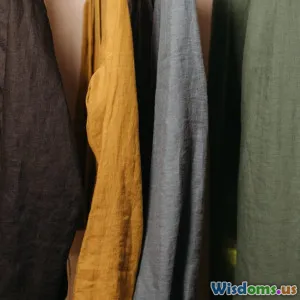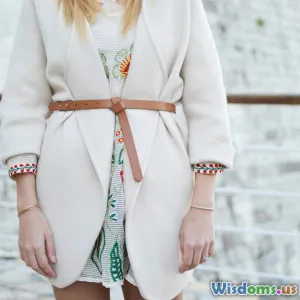
Zero Waste Fashion Design Lessons from Leading Brands
8 min read Explore actionable zero waste fashion design strategies from top brands pioneering sustainability in the apparel industry. (0 Reviews)
Zero Waste Fashion Design Lessons from Leading Brands
The fashion industry—often scrutinized for its environmental impact—experiences a rising shift toward sustainable, zero waste design practices. Imagine a world where every piece of fabric is utilized with mindful precision, eliminating waste and setting new standards for ethical fashion. This article dives into the revolutionary strategies implemented by leading brands dedicated to pristine, zero waste fashion. It’s more than a trend: it’s a paradigm shift raising the bar for creativity, sustainability, and responsible production.
Understanding Zero Waste Fashion Design
Zero waste fashion design centers around the radical goal of producing garments without generating textile scrap or excess offcuts. Traditionally, up to 15% of fabric is wasted during pattern-making and cutting processes, contributing to an estimated 92 million tons of textile waste generated worldwide each year according to the Ellen MacArthur Foundation.
Conceptually, the approach involves either redesigning patterns to interlock perfectly or regenerating unused materials back into the production cycle. This method aligns with circular economy principles by minimizing resource depletion and avoiding landfill contributions.
Why Leading Brands Are Embracing Zero Waste Design
Brands pursue zero waste design for numerous compelling reasons:
- Environmental Responsibility: Reducing textile waste drastically lowers environmental footprints.
- Economic Efficiency: Less waste can translate to material cost savings.
- Consumer Demand: Shoppers increasingly seek ethically and sustainably produced fashion.
- Innovative Brand Identity: Leading by example creates a trailblazing market position.
According to a Pulse of the Fashion Industry report by Global Fashion Agenda, integrating circular and zero waste practices could reduce fashion’s annual greenhouse gas emissions by up to 39% by 2030.
Case Studies: Lessons from Industry Pioneers
1. Zero + Maria Cornejo
Maria Cornejo’s label epitomizes minimalist, zero waste designs celebrated globally. Cornejo employs draping techniques that fully utilize or repurpose fabric offcuts into unique design details like pockets or lining. The brand's "Made in the USA" policy further emphasizes responsible manufacturing.
Key takeaway: Innovative draping coupled with thoughtful pattern development can turn waste reduction into an aesthetic brand signature.
2. **Timo Rissanen Projects (University of the Arts London)
Academically and professionally, Timo Rissanen advances zero waste by developing pattern engineering methodologies that achieve 0% waste or less than 2%. Rissanen’s pioneering designs show that zero waste doesn’t compromise style or fit but enriches garment architecture.
Insight: Advanced digital pattern techniques can optimize fabric usage mathematically, opening scalable zero waste applications for mass production.
3. **Eileen Fisher
Eileen Fisher appreciates zero waste as part of a holistic sustainability model. Her company mixes zero waste patterns with post-consumer textile recycling programs, collecting old garments for regeneration into new fabrics.
Example: Eileen Fisher's Renew program diverts thousands of pounds of clothing from landfill and exemplifies how zero waste complements a circular design ethos.
Zero Waste Design Techniques Explored
- Rotated and Mirrored Patterns
Pattern pieces are rotated and flipped to nest efficiently, resembling a puzzle. For example, fashion designer Holly McQuillan’s approach uses shapes designed to tessellate, maximizing fabric coverage.
- Modular and Multi-functional Pieces
Garments feature interchangeable components designed to share fabric. For instance, multiple garment sections come from the same cut piece or scraps.
- Laser Cutting and Digital Pattern Making
Cutting technology reduces human error and fabric waste. Digital pattern-making software incorporates fabric grain and pattern interlock algorithms to further optimize layouts.
- Alternative Fabric Uses
Offcuts are repurposed into accompanying accessories—belts, bags, patchwork—or incorporated into fabric dyes via scrap yarn regeneration.
- Fabric Selection Matters
Using fabrics with minimal stretch or directionality simplifies zero waste pattern creation. Natural fibers like organic cotton, hemp, and linen are often preferred for their lower environmental footprint.
Economic and Environmental Impact
Zero waste design shows encouraging ROI possibilities. In addition to reducing raw material costs by up to 15%, some designers report time savings as complex managing of offcuts is rendered unnecessary.
From an environmental standpoint, zero waste design helps address these alarming statistics:
- 1.4 billion pounds of textile waste sent to U.S. landfills in 2018 (EPA)
- Up to 25% of produced fabric wasted pre-consumer
Brands actively practicing zero waste are instrumental in decreasing such waste volumes, positively impacting water usage, carbon emissions, and landfill space.
Challenges and Future Outlook
Challenges
- Scalability: Complex zero waste designs can be difficult to scale mass production economically.
- Designer Training: Skills for zero waste cutting, digital patterning require specialized training.
- Consumer Awareness: Despite rising sustainability interest, price sensitivity remains a barrier.
The Future
Innovations in 3D body scanning, AI-driven pattern optimization, and textile innovations (e.g., biodegradable synthetics) promise to accelerate zero waste adoption.
Collaborations between brands, tech companies, and education institutions like Timo Rissanen's illustrate a shared path forward.
How Consumers Can Support Zero Waste Fashion
- Prioritize brands publicly committed to waste reduction and transparency.
- Purchase fewer, higher-quality items designed with zero waste principles.
- Advocate for policy incentives encouraging zero waste production.
- Educate themselves and communities about textile waste impacts.
Conclusion
Zero waste fashion design is more than a novel technique—it is a critical movement redefining how clothes are created, consumed, and valued. Leading brands provide inspiring, tangible examples showcasing that eliminating textile waste is possible without sacrificing style or quality. By embracing these lessons, the fashion industry can align innovation with responsibility, crafting garments that honor both people and planet.
The responsibility is shared: designers, manufacturers, and consumers collectively hold the power to drive this zero waste revolution, stitching together a sustainable future for fashion.
References:
- Ellen MacArthur Foundation, "A new textiles economy: Redesigning fashion’s future, 2017"
- Global Fashion Agenda, "Pulse of the Fashion Industry, 2018"
- U.S. EPA, Facts and Figures about Materials, Waste and Recycling, Textile Recycling, 2020
- Rissanen, T., McQuillan, H., "Zero Waste Fashion Design, 2016"
- Eileen Fisher Corporate Responsibility Report, 2022
Rate the Post
User Reviews
Popular Posts



















